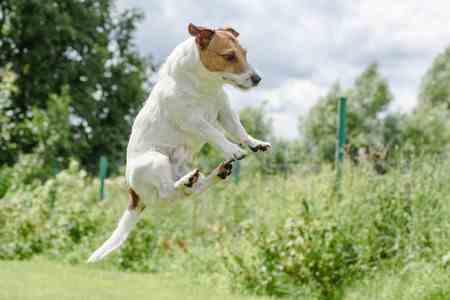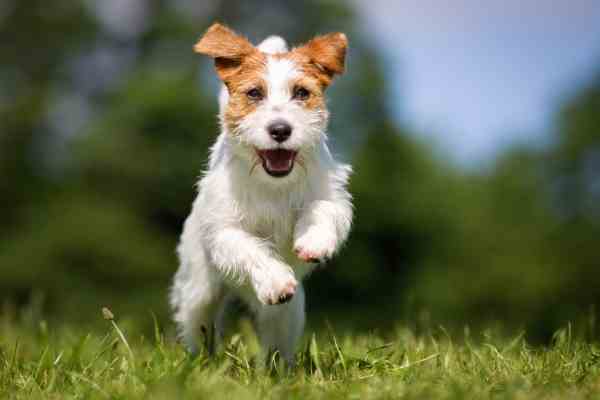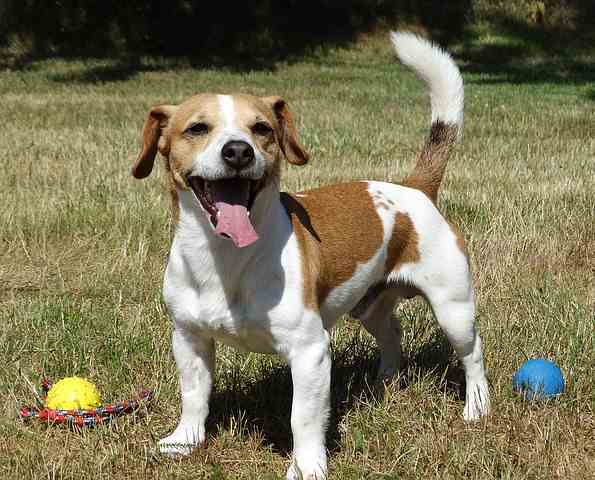- Small Dog Place Home
- A-Z Breeds A to M
- Jack Russell Terriers
Jack Russell Terriers: Cuteness, Tenacity, and Energy
Last Updated 06-20-2-22
Jack Russell Terriers are incredibly cute, curious and always ready for a new adventure. But don’t let their clever antics and friendly appearance deceive you. They are independent minded with energy to spare and those traits coupled by high intelligence makes these dogs a challenge to own.
They love having fun and if their activity is restricted or they do not get enough exercise, your fun loving Jack will turn destructive, aggressive or highly vocal.
Here are more Quick Jack Russell Terrier Facts
Jack Russell Terriers are terriers through and through. Their coat colors and textures may vary, but in general, they have strong forelegs, a tail that is set high and carried slightly over the body, and small triangular ears that drop forward.
Unlike two very similar breeds, the Parson Russell Terrier and the Russell Terrier, Jacks are somewhat more diverse in appearance. They are bred more for their hunting ability than their appearance and therefore are not registered with the American Kennel Club.
Quick Facts
Height (inches & cm) 10-15 inches
Weight (lb & kg) 13 – 17 pounds
Coat Type: Smooth, Rough or Broken
Colors: White with tan, black or brown markings
Country of Origin: England
Activity Level: Very energetic
Life Expectancy: 11-15 years
Good with Children: Yes
Good with other pets:
Varies: They cannot be trusted
around small pets such as guinea pigs and males may be somewhat aggressive
around other males. Otherwise, they do well with other dogs.
History of Jack Russell Terriers
The Jack Russel Terrier and the other two breeds, the Parson Russell and the Russell can all be traced back to one person, the Reverend or Parson Jack Russell, born in 1795.
First called Fox Terriers, the name was changed in the late 1800s to honor the person most responsible fore creating the new breed, the Reverend John Russell of Dartmouth, England. As a young man, Russell had a keen love of fox hunting and developed an interest in dog breeding.
In the early days, the fox terrier breed did not resemble today’s Jack Russell Terriers. It was taller, slender and lanky and the coloring was predominantly black, tan and reddish brown. Using a dog like this on a fox hunt was risky because they resembled the foxes they were hunting.
He wanted a great hunting dog with colors that would not confusing the dog with the prey and started his new breed with a young female white terrier with dark spots over her eyes, ears and tail.
Using this first dog, “Trump,” along with other British White Terriers (now extinct) he carefully bred generations of dogs. The British White Terrier was considered a lap dog because they ranged in size from 10 to 20 pounds and rarely used for much other than companionship.
The breed was also prone to deafness. After 12 years, Russell was able to create a new line of dogs that were popular with hunting enthusiasts and British aristocrats.
Russell was known at the time as “the Sporting Parson” and many of his close friends called him Jack.
After Russell’s death, the dogs remained popular and at times may have been crossed with Dachshunds, Corgis, and other small terriers which resulted in major variations in size, shape and type.
At the time, the Kennel Club in England would not accept the breed due to this variability. Enthusiasts found their own Jack Russell Terrier Club in 1974.
This group split in 1980 into two camps, one who wanted to impose a breed standard that would allow them to gain admittance to The Kennel Club and the other group who preferred the qualities of temperament and working ability over appearance.
The first group formed the Parson Jack Russell Terrier Club and was recognized by The Kennel Club in England in 1989. The American Kennel Club later accepted the breed in 1997 and placed it in their Terrier Group.
The other group continued as the Jack Russell Terrier club in both England and the U.S.
Personality of Jack Russell Terriers
 Jack Russell Terriers can be amazing high jumpers.
Jack Russell Terriers can be amazing high jumpers.If you are considering a Jack Russell Terrier, the first thing to keep in mind is their history and why they were developed in the first place.
Farmers and Sportsmen needed a small hunting dog that could follow a scent, bark to alert the person of their find, dig down under ground to flush out foxes or other small animals.
To do these jobs, the dog needed to be fearless, assertive, and tireless. Their skills included running and chasing, digging, barking, and the show of aggression.
Most of these traits that come naturally to them are not behaviors that the average pet owner wants to deal with.
They think of themselves as a big dog in a little body and will let everyone around know who’s boss if permitted to do so. For these reasons, this little dog may not be the best choice for a first time dog owner.
Do not think that the cute little Jack Russell you saw in photos, movies or other types of media is the type of puppy you will be getting.
(Remember Wishbone from the PBS Children’s Show or Eddie on the TV Series Frasier?)
These dogs have been trained to do certain tasks and can perform them on command for short periods of time. Off the set, they are a typical terrier: energetic, independent, and assertive.
Jack Russell Terriers are very loyal and affectionate. They want to be with people all the time. They are also keenly alert and will alert you to every new person, animal or thing encroaching on their property.
As hunters, they are also barkers, but some of the nuisance barking can be trained out. With all that love that they bestow on their family, they also come equipped with some behaviors that may not be as positive.
They are extremely intelligent and clever and will continue to test their limits. Training is important, not only in puppyhood, but throughout the life span.
They have been known to train their owners through assertive and even aggressive behaviors. Socialization is very important both with people and other animals, especially other dogs.
They may bond to one person in the household and show signs of possessiveness if given the opportunity.
They may show their dislike in having to share their favorite human through displays of aggression. Controlling this behavior needs to begin in puppyhood and maintained throughout the life. To avoid problems.
More Information about Jack Russell Behavior Issues.
Energy to Spare
These dogs are very energetic and require a great deal of exercise.
Consider them a working dog that must have a job to do and not a suitable match for a couch potato. They are not going to cuddle on your lap and watch television all day.
Jack Russell Terriers were bred to work, whether it was keeping a stable free of rats, digging after quarry or chasing small prey. If they are to be a companion dog, they will need daily walks or jogs, playing fetch, or participating in a dog sport.
Apartment Life?
This is one small breed that may not be appropriate in an apartment. The ideal home would be in a rural or suburban setting with a large securely fenced yard.
A fence is a must and remember that Jack Russell Terriers love to dig, jump, or even climb, so the fence must prevent all those forms of escape.
Live in an apartment or condo and have your heart set on a Jack Russell? There is no doubt about it, this breed thrives in places where it can run, chase and just have fun. But there are plenty of examples where they have also done fine living in small apartments.
The trick is to be able to provide the necessary exercise these dogs need. Expect to spend at least an hour a day exercising your Jack Russell Terrier.
Jack Russell Terriers and Other Pets?

These dogs cannot be trusted around other small pets such as cats, birds, hamsters or simple pocket pets due to their strong prey drive.
Some breeds can co-habitate with cats if raised together but not necessarily the Jack Russell Terrier.
If you do have a small pet, protect him/her and do not permit your Jack Russell Terrier to even enter the room where you little pet lives.
Jacks do relatively fine with other dogs.
Children and Jack Russell Terriers?
Jack Russell Terriers do best with older respectful children who have been taught how to handle a dog without teasing, or mistreating them. They are likely to be too much for children under 6 years of age.
Grooming Jack Russell Terriers
Jack Russell Terriers come in one of three different coat types: smooth, broken, and rough. The type of coat will determine the amount of grooming required.
All coat types will shed! Smooth coats shed the most year round. The rough coat sheds, but the dead hairs remain within the coat requiring stripping, brushing, or clipping several times a year. The broken coat is considered to be somewhere in the middle between the rough and the smooth coat.
The broken coat is very comparable to a smooth coat but has whiskers around their face and extra hair on their legs or body. It is not soft or smooth but rather harsh to repel rain, snow and other weather conditions.
The rough coat has the most hair all over the body and it can be straight or wavy. This coat requires the most grooming.
The smooth coat and broken coats are the easiest to maintain. Brush these coats about once a week to cut down on the amount of shedding in the home. If brushed regularly, frequent bathing is not normally needed. Dried dirt or mud can often be removed through brushing but you can also bathe them if they get dirty (and they will).
The rough coat will need brushing too and stripping several times a year to remove dead hair.
Stripping can be done professionally or you can learn to do it yourself at home. Some owners opt for clipping the coat. For those Jack Russell Terriers that are not involved in showing, clipping may be a less expensive option.
The hair that results after being clipped is softer and may even appear lighter in color. This method does not remove the dead hair, just shortens and makes the dog look more attractive.
Their nails will need to be trimmed or filed down using a
nail grinder about every two weeks.
It is also recommended that their teeth be brushed several times a week to prevent tarter from forming.
Health Concerns of Jack Russell Terriers

The breed is considered to be healthy with a life span of between 11 and 15 years. Many live longer than that if given proper nutrition and care.
There are some conditions that have been
identified as having a genetic component, some of which may have genetic tests
that can be performed on the parents before breeding.
The list of heritable conditions of this
breed is extensive on the Jack Russell Terrier Club of America website, but
despair. Some breed clubs are more
conscientious at identifying problems with the goal of eradicating them.
Cataracts
Cataracts may occur due to heredity or caused by diabetes, old age or injury. The lens of the eye hardens and appears cloudy. Vision is blurry and can eventually be lost entirely. Cataracts can be removed and vision restored.
Lens Luxation
Ectopia Lentis or Lens Luxation occurs when the lens becomes dislocated. There are two types There are two types, posterior luxation (where the lens slips to the back of the eye) and anterior luxation (where the lens slips forward). Anterior luxation also has a high probability of causing glaucoma which can lead to partial or complete blindness.
Patellar Luxation
Patellar Luxation or luxating patella is an hereditary problem that affects the knees. The kneecap slips in and out of the groove where it would normally sit. When it slips out, the dog may hold the leg up until the kneecap goes back into place. It can eventually lead to lameness and arthritis.
Cerebellar Ataxia
This is a neurological disorder resulting from degeneration of the cerebellum’s cortex. The degeneration can progress steadily and cause a stagger in the dog’s gait. If your terrier appears wobbly or disoriented from time to time, this disorder could be the cause.
Myasthenia Gravis
This malady affects the motor nerves and causes weakness in the hindquarters.
A dog with this condition can have difficulty in rising from a sitting position and will sway and stagger when walking. So this covers some of the inherited Jack Russell Terrier health problems.
It must be noted that dogs that are affected with these disorders should not be bred from.
vonWillebrand Disease
vonWillebrand Disease
(vWD) is an inherited bleeding disorder caused by an insufficient vonWillebrand
factor, the blood protein that binds platelets to blood vessels.
This problem is often observed when the dog
bleeds more than normal during estrus or after surgery.
Bleeding can also be observed from the gums, nose or in urine. Cutting slightly into the blood vessel of the nails can cause profuse bleeding that requires much time to clot.
Legg-Calve-Perthes Syndrome
The disease is caused by the ball and socket joint in the hip degenerating, leading to pain, stiffness and reduced movements.
Skunk problems
Being a hunt-driven dog, the Jack Russell will usually pursue most creatures that it encounters. This includes the and the breed is prone to skunk toxic shock syndrome.
Pros and Cons of the Jack Russell Terrier
Pros
- Friendly, Affectionate, Playful
- Smooth coats require little grooming
- Good around older children
- Healthy Breed
- Great Stamina
Cons
- Intense energy needs
- Training is ongoing and can be challenging
- Not good for people in apartments or condos
- Bad habits including digging, chewing, chasing, barking
Books Worth Reading
Before you get your first Jack Russell Terrier, you should spend just a little bit more time researching the breed. Here are a couple of good books that Small Dog Place recommends.
Just For the Jack Russell Terrier Lover
About Janice (author and voice behind this site)
Having lived with dogs and cats most of her life, Janice served as a veterinary technician for ten years in Maryland and twelve years as a Shih Tzu dog breeder in Ohio.
Her education includes undergraduate degrees in Psychology with a minor in biology, Early Childhood Education, and Nursing, and a master's in Mental Health Counseling.
She is a lifelong learner, a dog lover, and passionate about the welfare of animals. Her favorite breed for over 50 years has been the Shih Tzu, but she has also lived with Poodles, Maltese, Yorkshire Terriers, Beagles, English Bulldogs, Carin Terriers, and a Cocker Spaniel.
When not writing, reading, and researching dog-related topics, she likes to spend time with her eight Shih Tzu dogs, husband, and family, as well as knitting and crocheting. She is also the voice behind Miracle Shih Tzu and Smart-Knit-Crocheting
Does This Article Deserve Your Thumbs Up?
We always appreciate your support and encouragement. Your thumbs up means so much to us. Please like this article.
If you find this page or any page on Small Dog Place Helpful, or useful in anyway, I'd love it if you would click the small heart found on the bottom right of each page.
You can also share or bookmark this page -- just click on the:

Free Monthly Newsletter
Sign Up for Our Free Newsletter and get our Free Gift to You.
my E-book, The Top 10 Mistakes People Make When Choosing a Dog (and how to avoid them)








